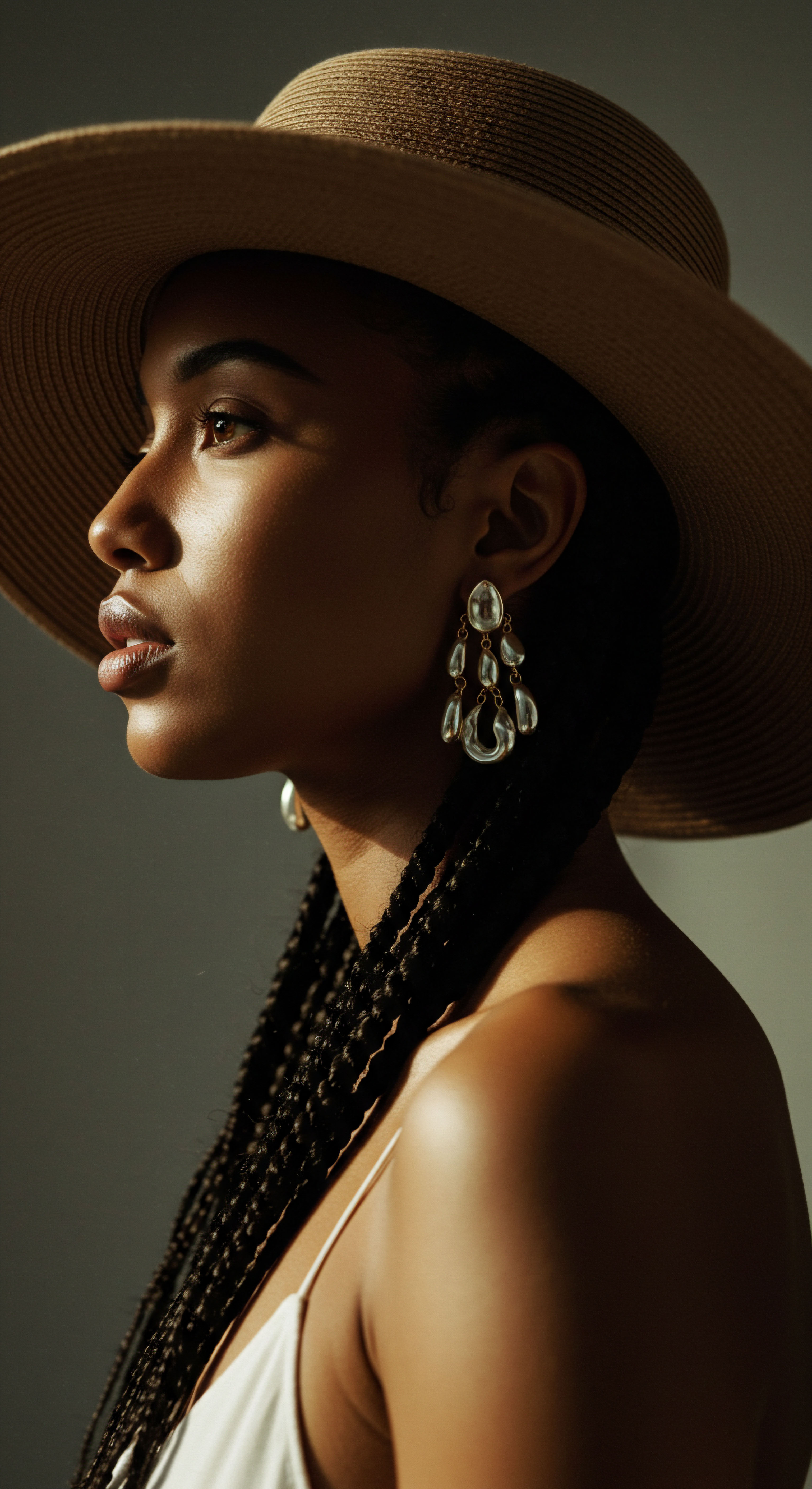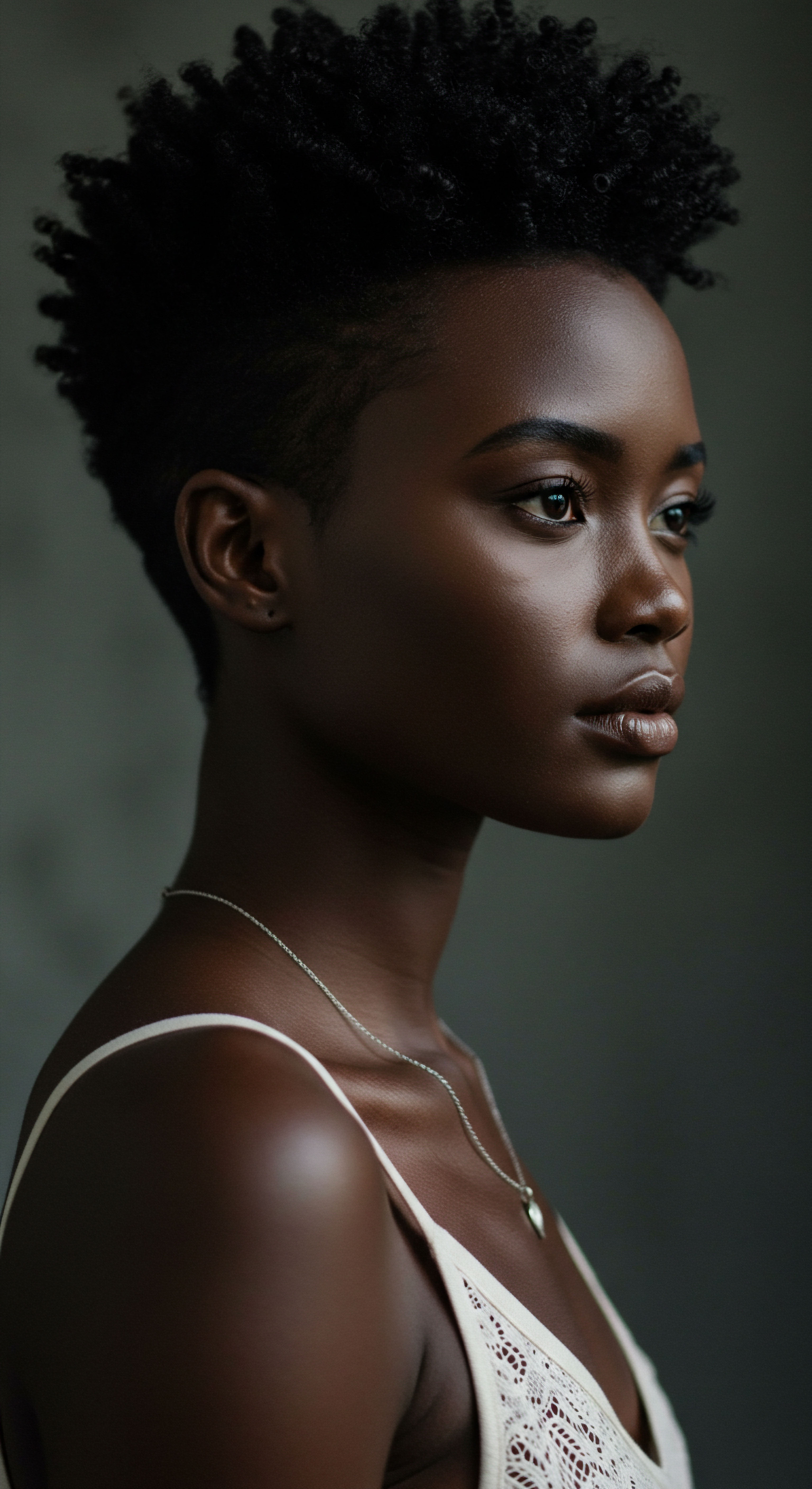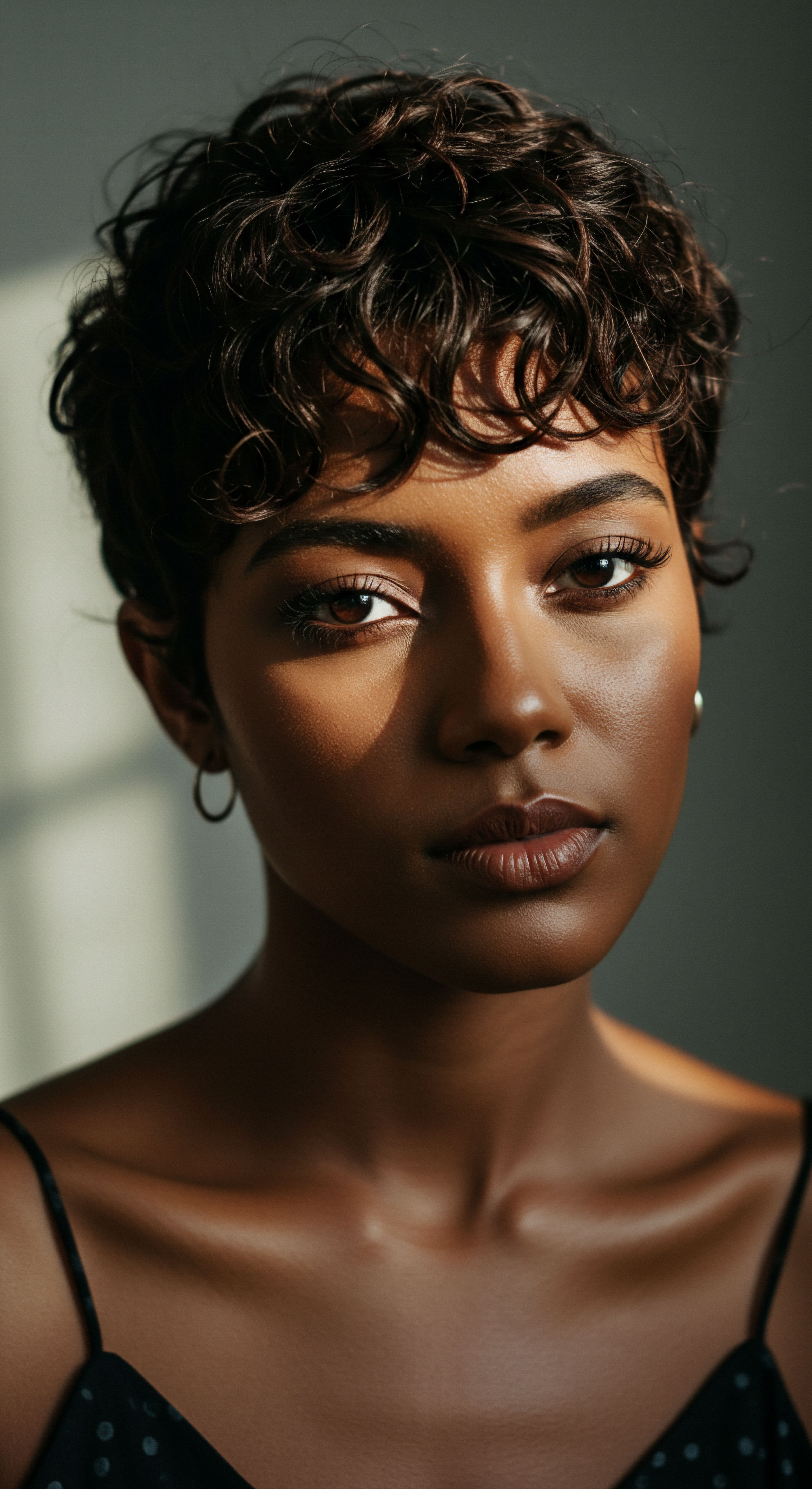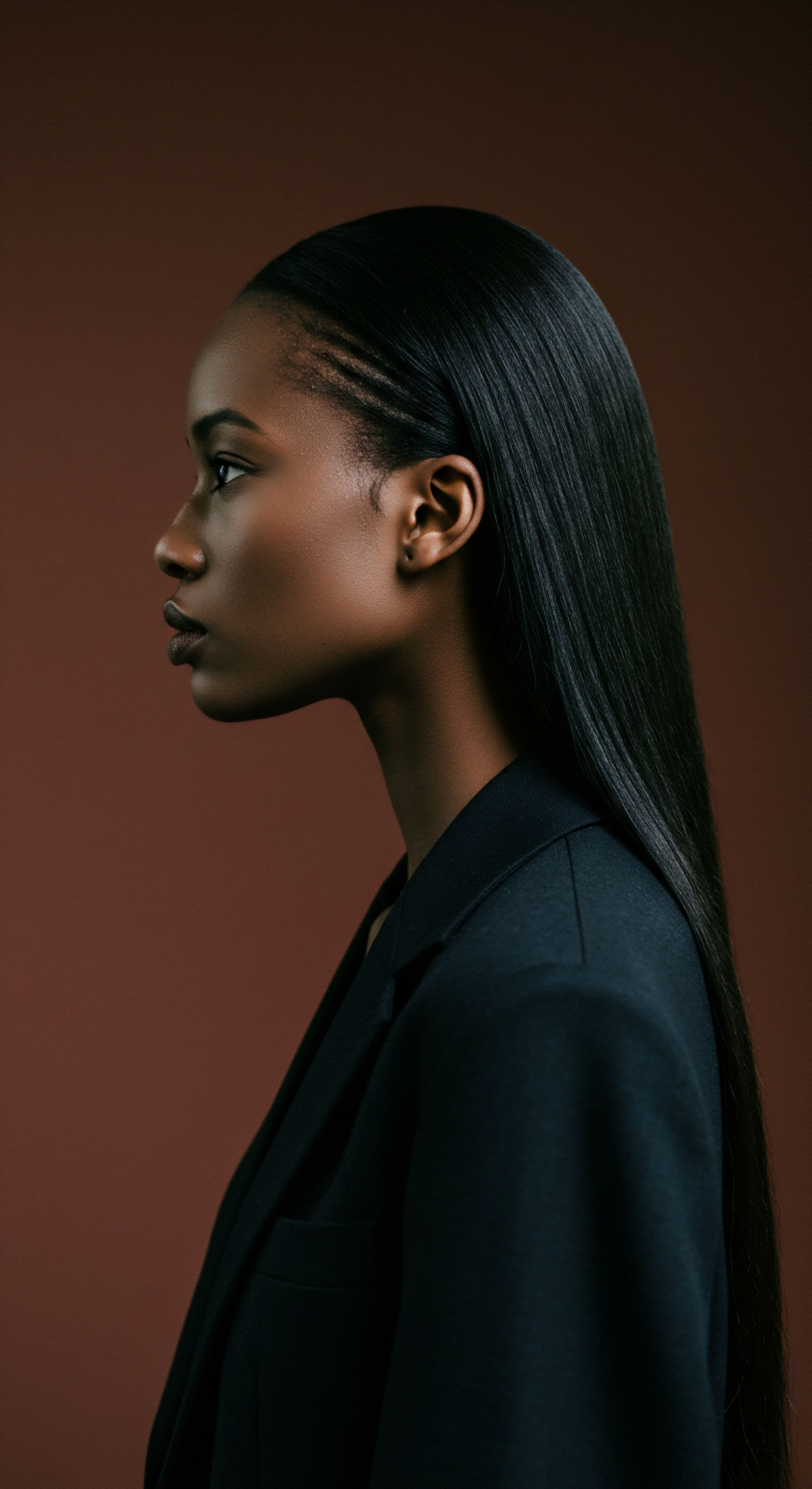
Roots
The quiet hours of night, when the world softens and silence settles, hold a profound power over the well-being of our textured strands. We spend roughly a third of our lives in slumber, and during this restorative period, our hair, particularly its delicate structure, encounters the subtle yet persistent forces of friction and moisture exchange. Understanding the foundational science behind these nightly interactions allows us to appreciate the profound impact of what we choose to rest our heads upon, or rather, what we choose to cover them with. It is a matter of preserving the intrinsic vitality of each coil and curl, protecting against the slow, unseen attrition that can diminish its luster and strength.
The very architecture of textured hair, with its unique bends and turns, renders it more susceptible to mechanical wear. Each twist in a strand presents a point of vulnerability, a place where the outer cuticle layer, the hair’s protective shield, can lift or chip away when met with abrasive surfaces. When we move in our sleep, shifting and turning, these points of contact become tiny arenas of friction. This constant rubbing against a pillow or an unsuitable head covering can lead to microscopic damage, accumulating over time to manifest as frizz, dryness, and even breakage.
The delicate structure of textured hair necessitates thoughtful nighttime protection against friction and moisture loss.

Hair Anatomy and Nocturnal Vulnerability
At the microscopic level, each hair shaft comprises three primary layers ❉ the medulla, the cortex, and the cuticle. The outermost layer, the Cuticle, consists of overlapping, scale-like cells that lie flat, much like shingles on a roof, in healthy hair. This smooth arrangement reflects light, contributing to hair’s shine, and provides a barrier against external stressors. For textured hair, the cuticle may not lie as flat as in straight hair types, making it inherently more prone to lifting.
Nightly friction exacerbates this tendency, causing these scales to raise further, leading to a rougher surface. This rougher surface then catches on other strands and fabrics, creating a cyclical pattern of damage.
Beyond mechanical stress, the night also poses a challenge to hair’s moisture content. Our hair’s natural oils, sebum, travel down the hair shaft, providing a natural conditioning effect. However, certain materials can draw moisture away from the hair, acting like sponges.
This hygroscopic action, the absorption of water from the air or from a contacting surface, means that if a head covering readily absorbs moisture, it can deplete the hair of its much-needed hydration, leaving it parched and brittle by morning. A deeper acquaintance with these fundamental principles of hair science forms the basis for choosing protective coverings that work in harmony with our hair’s natural needs.

How Does Friction Affect Hair?
The concept of friction is central to understanding hair damage during sleep. When two surfaces rub against each other, friction occurs. For hair, this means the cuticle scales are subjected to constant agitation.
Over time, this agitation can cause the cuticle to fray, leading to a loss of the hair’s natural smoothness and integrity. This process is particularly pronounced in textured hair due to its inherent coily or curly structure, which creates more surface area for contact and more points where strands can snag.
The damage from friction manifests in several visible ways:
- Frizz ❉ Raised cuticles cause individual strands to stand away from the main body of hair, creating a halo of frizz.
- Breakage ❉ Continued friction weakens the hair shaft, making it more susceptible to snapping, particularly at the mid-shaft or ends.
- Dullness ❉ A compromised cuticle layer scatters light rather than reflecting it, leading to a lack of shine.
- Tangles ❉ Roughened hair surfaces cling to each other, forming knots and tangles that are difficult to comb out without causing further damage.

Ritual
As the day draws to a close and the quiet moments before rest beckon, a thoughtful nighttime ritual becomes a quiet act of devotion to our hair. This transition from the demands of the day to the calm of night presents an opportunity to safeguard our strands, particularly for those with textured hair, against the rigors of sleep. The right sleep head covering transforms the simple act of slumber into a protective ceremony, preserving moisture, minimizing friction, and maintaining styling efforts. It is about making a conscious choice to support our hair’s vitality while we recharge.
The choice of material for a sleep head covering stands as a primary consideration in this nightly care. Certain materials offer a gentle glide, allowing hair to move freely without snagging, while others act as guardians of moisture, keeping hydration within the hair shaft rather than absorbing it. This practical wisdom guides us toward materials that truly serve the purpose of hair protection, moving beyond mere comfort to a deeper understanding of material science.

Material Properties for Hair Protection
When considering materials for sleep head coverings, two properties stand out ❉ surface smoothness and moisture absorbency. A material with a smooth surface, often described as having a low coefficient of friction, allows hair to slide across it with minimal resistance. This gentle interaction prevents the lifting and abrasion of the hair’s delicate cuticle layer. Conversely, highly absorbent materials can draw essential moisture from the hair, leading to dryness and brittleness over time.
Let us consider some common and favored materials for sleep head coverings:
- Silk ❉ Revered for its incredibly smooth surface, silk minimizes friction against hair. It is also a protein fiber, making it less absorbent than many plant-based fibers, thus helping hair retain its natural moisture.
- Satin ❉ Often confused with silk, satin refers to a type of weave, not a fiber. Satin can be made from various fibers, including polyester. When made from polyester, it still offers a smooth surface, reducing friction, but its moisture-retention properties may differ from natural silk.
- Cotton ❉ While comfortable and breathable, cotton is a highly absorbent fiber. It can wick moisture away from the hair, potentially leading to dryness, and its coarser fibers can create more friction, causing frizz and breakage.

Why Material Choice Matters for Textured Hair?
The unique coiled and curled patterns of textured hair mean that each strand presents numerous points of contact with a surface. Unlike straight hair, which might glide more uniformly, textured hair can snag and pull more easily. This structural reality makes the choice of sleep covering material even more critical. A smooth, non-absorbent material becomes not just a preference, but a fundamental aspect of preserving the hair’s integrity.
For instance, a study published in the Journal of Cosmetic Dermatology in 2021 explored the impact of fabric on hair damage, specifically comparing silk and cotton. The researchers observed that Silk Pillowcases Significantly Reduced Hair Breakage and Friction Compared to Cotton Pillowcases in participants with varying hair types. This finding underscores the tangible protective benefit of silk’s smooth surface. This empirical evidence reinforces the long-held wisdom within textured hair communities about the benefits of silk.
A smooth, non-absorbent material for sleep coverings is not merely a comfort; it is a fundamental choice for preserving hair integrity.
The implications of this research extend beyond pillowcases to sleep head coverings like bonnets and scarves. If a silk pillowcase can mitigate damage, a silk or satin bonnet provides an even more direct and comprehensive shield, enveloping the hair completely.
Here is a comparison of material properties for sleep head coverings:
| Material Silk (e.g. Mulberry Silk) |
| Surface Smoothness Very High (Low Friction) |
| Moisture Absorbency Low (Moisture Retaining) |
| Typical Cost Higher |
| Material Satin (Polyester) |
| Surface Smoothness High (Low Friction) |
| Moisture Absorbency Moderate (Less Absorbent than Cotton) |
| Typical Cost Moderate |
| Material Cotton (Standard) |
| Surface Smoothness Low (High Friction) |
| Moisture Absorbency Very High (Moisture Wicking) |
| Typical Cost Lower |
| Material Bamboo (Viscose) |
| Surface Smoothness Moderate to High |
| Moisture Absorbency Moderate (Breathable, but can absorb) |
| Typical Cost Moderate |
| Material Silk offers superior hair protection due to its exceptional smoothness and moisture-retaining qualities. |
While cotton might feel soft to the touch, its microscopic fibers are structured in a way that creates more friction with hair. This microscopic roughness, invisible to the eye, is the silent antagonist of healthy hair. Conversely, the tightly woven, smooth fibers of silk and good quality satin allow hair to glide, preventing snags and minimizing cuticle disturbance.

Relay
Moving beyond the immediate considerations of material and nightly ritual, a deeper understanding of sleep head coverings invites us to consider their role within a broader context of hair health, cultural practice, and scientific inquiry. The choice of what covers our crowns at night is not merely a practical decision; it is a point where ancestral wisdom meets modern trichology, where personal comfort intersects with biomechanical realities. What deeper truths do our sleep coverings whisper about our hair’s vitality and our approach to self-care?
The scientific community continues to explore the complex interplay between textiles and hair. The study previously mentioned, published in the Journal of Cosmetic Dermatology in 2021, provided a compelling comparison between silk and cotton pillowcases. This research measured parameters such as hair breakage and friction coefficient, finding that Silk Significantly Outperformed Cotton in Reducing Mechanical Stress on Hair. Such empirical data validates what many with textured hair have intuitively understood for generations ❉ the surface our hair rests upon profoundly influences its condition.

The Biomechanics of Hair Protection
The protective qualities of sleep head coverings can be understood through the lens of biomechanics, particularly the concept of the Coefficient of Friction. This value quantifies the resistance to motion when two surfaces slide against each other. A lower coefficient of friction means less resistance and smoother movement.
Hair, when interacting with a fabric, experiences friction. High friction can lead to physical abrasion of the hair cuticle, as individual strands rub against the textile fibers.
Silk, a natural protein fiber, exhibits a remarkably low coefficient of friction against human hair. Its smooth, long, and tightly packed fibers create a surface that allows hair to glide rather than snag. In contrast, cotton fibers, being shorter and coarser, tend to create more microscopic resistance, leading to increased friction. This difference in tribological properties directly impacts the mechanical integrity of the hair shaft over prolonged periods of contact, such as during sleep.
Beyond friction, the hygroscopic nature of materials also plays a crucial role. Hygroscopy refers to a material’s ability to attract and hold water molecules from the surrounding environment. Cotton is a highly hygroscopic material, readily absorbing moisture. While this makes cotton towels effective for drying, it poses a challenge for hair protection during sleep.
A cotton covering can absorb the natural oils and moisture from hair, leaving it dry and susceptible to breakage. Silk, conversely, is less absorbent, allowing hair to retain its natural hydration throughout the night.

Do Hair Coverings Impact Scalp Health?
The conversation around sleep head coverings often centers on hair strands, but the scalp, the very foundation of healthy hair, also warrants attention. The scalp is a living ecosystem, home to a delicate balance of microorganisms that constitute the Scalp Microbiome. While research directly linking sleep head covering materials to the scalp microbiome is still developing, general principles of scalp health apply.
Maintaining a breathable environment for the scalp is paramount. Overly tight or non-breathable coverings could potentially create a warm, moist environment conducive to the overgrowth of certain yeasts or bacteria, potentially leading to scalp irritation, itching, or even conditions like seborrheic dermatitis. Materials that allow for air circulation while still offering protection are generally preferable. Silk and satin, being relatively breathable while providing smoothness, typically strike a good balance.
The cultural significance of head coverings for hair protection has deep roots in many communities, particularly those with textured hair. For generations, women have utilized scarves, wraps, and bonnets as part of their nightly rituals, understanding intuitively the protective qualities of smooth fabrics. This practice was often passed down through families, a quiet wisdom recognizing the vulnerability of hair to the elements and to friction during sleep. This ancestral knowledge, now increasingly supported by scientific inquiry, highlights a profound continuity between tradition and modern understanding.
Ancestral wisdom regarding hair protection through coverings finds compelling validation in modern scientific study.
Consider the broader implications for hair health. Consistent use of appropriate sleep coverings can lead to:
- Reduced Breakage ❉ Less friction means fewer snapped strands and improved length retention.
- Maintained Moisture ❉ Non-absorbent materials help hair stay hydrated, reducing dryness and frizz.
- Preserved Styles ❉ The smooth surface helps to maintain curls, coils, and protective styles, extending their longevity and reducing the need for daily manipulation.
- Improved Shine ❉ A protected cuticle layer remains smooth, reflecting light more effectively.
The long-term impact of choosing the right sleep head covering is cumulative. Over weeks, months, and years, the consistent reduction in friction and moisture loss translates into noticeably healthier, stronger, and more vibrant hair. It is a testament to the power of small, consistent acts of care, deeply rooted in both scientific understanding and cultural practice.

Reflection
As the quiet of night descends, the choice of what graces our heads becomes more than a simple habit; it stands as a testament to mindful care, a quiet commitment to the vitality of our textured strands. From the foundational whisper of friction to the rich chorus of cultural practices, the wisdom of protecting our hair during slumber echoes through generations and finds grounding in scientific discovery. Each silk bonnet, each satin scarf, holds within its gentle embrace the promise of preserved moisture and minimized mechanical stress.
This journey from understanding hair’s delicate architecture to embracing a thoughtful nightly ritual underscores a profound connection between self-care and the inherent beauty of our crowns. May our nights be as restorative for our hair as they are for our spirits.

References
- Song, S. H. Park, J. H. & Na, J. Y. (2021). The effect of fabric on hair damage ❉ a comparative study of silk and cotton. Journal of Cosmetic Dermatology, 20(1), 324-329.
- Robbins, C. R. (2012). Chemical and Physical Behavior of Human Hair (5th ed.). Springer.
- Giacomoni, P. U. (2016). Hair Care ❉ An Illustrated Dermatologic Handbook. Springer.
- Trueb, R. M. & Gavazzoni Dias, M. F. R. (Eds.). (2016). Female Alopecia ❉ Guide to Diagnosis and Management. Springer.
- Bouillon, C. & Wilkinson, J. B. (Eds.). (2005). The Science of Hair Care (2nd ed.). CRC Press.
- Pugh, A. L. & Khondker, S. M. (2023). Hair and Scalp Disorders ❉ A Practical Guide to Diagnosis and Treatment. Springer.